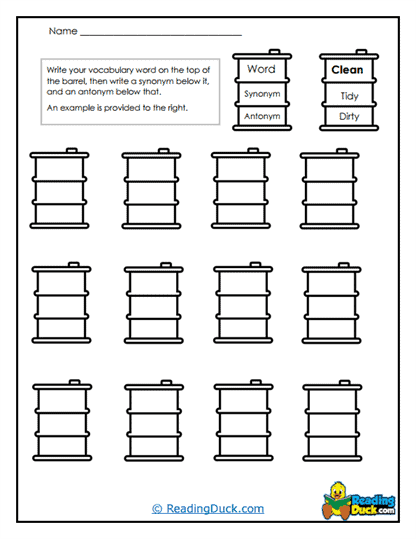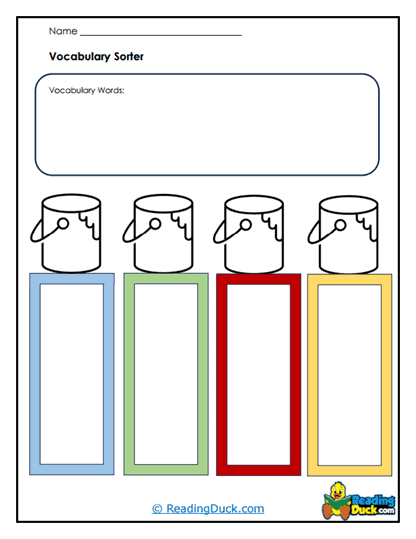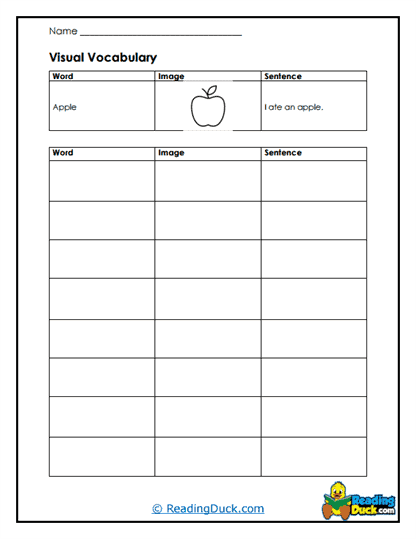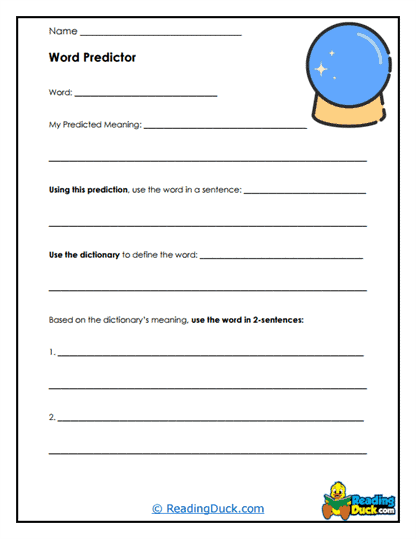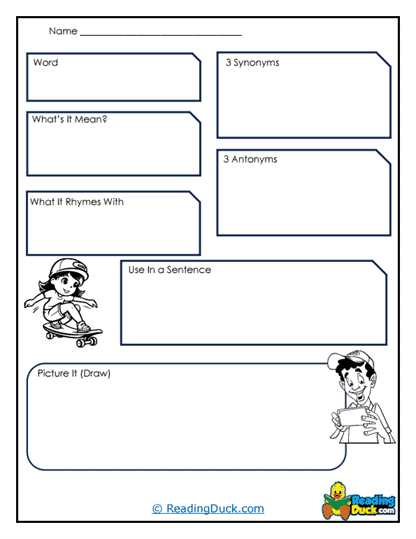Vocabulary Graphic Organizers Worksheets
About Our Vocabulary Graphic Organizers
Vocabulary graphic organizers are visual tools designed to support the acquisition and understanding of new words, phrases, and linguistic structures. They serve as structured frameworks that allow learners to break down complex vocabulary concepts into manageable and visually appealing parts. These tools help learners engage with words in a deeper, more meaningful way, fostering better retention and application in reading, writing, speaking, and listening. They can be helpful in many different ways:
Aid Comprehension
Vocabulary graphic organizers serve as essential tools to enhance comprehension by bridging the gap between new vocabulary and prior knowledge. When learners can visually map out how a word fits into their existing understanding, they build stronger connections and grasp deeper meanings. These tools also demonstrate how words function in various contexts, whether through synonym exploration, sentence creation, or categorization. By organizing information in a structured way, learners are better equipped to decode complex texts and retain nuanced language features. Ultimately, these organizers transform abstract words into relatable, digestible concepts that enhance overall literacy skills.
Promote Retention
Retention of vocabulary improves significantly when learners engage multiple senses during the learning process, and graphic organizers are instrumental in this multisensory engagement. Visual learners benefit from seeing connections between words, while kinesthetic learners engage actively as they write, draw, or manipulate elements of the organizer. In some cases, auditory input can be incorporated by discussing the words aloud in pairs or groups. By involving these diverse learning pathways, vocabulary organizers reinforce memory and create a layered understanding of new words. The repeated exposure and interaction with vocabulary in various forms make long-term retention more likely and effective.
Encourage Critical Thinking
Vocabulary graphic organizers go beyond mere memorization, challenging learners to think critically about language. When students analyze a word's roots, affixes, and grammatical forms, they delve into the structural intricacies of language. Synthesizing information from multiple sources, such as synonyms, antonyms, and examples, fosters a more comprehensive understanding. Organizing this information visually encourages learners to spot patterns, draw conclusions, and question ambiguities. This process not only builds a robust vocabulary but also equips students with the analytical skills to navigate language complexities in reading and communication.
Support Differentiated Learning
One of the most powerful features of vocabulary graphic organizers is their adaptability to meet the needs of diverse learners. Visual learners benefit from diagrams and spatial layouts, while English Language Learners (ELLs) find structured guidance in navigating unfamiliar vocabulary. For students with learning differences, these organizers provide clarity and reduce cognitive load, enabling them to focus on core concepts. Teachers can tailor these tools by adjusting the complexity, adding scaffolding, or incorporating culturally relevant examples. This flexibility ensures that all students, regardless of their starting point, can engage meaningfully with vocabulary.
Key Components
Word Exploration
At the heart of every vocabulary graphic organizer is the process of exploring a focus word or phrase. This exploration begins with selecting a word that aligns with the lesson's objectives, ensuring relevance and purpose. Once chosen, students break down the word into its key elements, such as meaning, context, and usage. This in-depth examination allows learners to engage with the word beyond surface-level definitions, fostering curiosity and deeper connections. Word exploration lays the foundation for a nuanced understanding, ensuring students can apply the vocabulary in diverse contexts.
Definition
Including a definition section in the graphic organizer helps students anchor their understanding of a word. Definitions can be tailored to the learner's level, ranging from simple, everyday explanations to technical, discipline-specific meanings. Writing definitions in their own words encourages learners to internalize the concept rather than passively memorize. Teachers can further enrich this component by asking students to compare multiple dictionary definitions, analyze subtle differences, and decide which is most applicable to the context. By doing so, students gain a more precise and practical grasp of the word.
Synonyms and Antonyms
The inclusion of synonyms and antonyms allows learners to expand their vocabulary networks. Listing related words helps students understand subtle shades of meaning, while antonyms clarify oppositional concepts. This dual exploration fosters a deeper grasp of the focus word and broadens linguistic flexibility. For instance, understanding the antonym of "brilliant" as "dull" also reinforces the meaning of "brilliant." This process supports learners in making connections between words, enabling more dynamic expression and comprehension across contexts.
Contextual Usage
Contextualizing vocabulary is a critical step in ensuring practical application. By encouraging students to use the focus word in sentences or identify scenarios where it might appear, organizers connect vocabulary to real-life usage. For example, understanding "meticulous" in the context of a detailed artist's work helps students grasp its meaning beyond abstract definitions. This component reinforces language's functional nature, equipping students to apply vocabulary confidently in writing, speaking, and reading comprehension.
